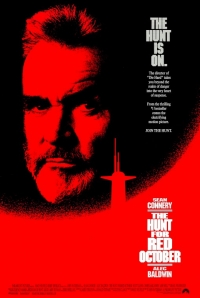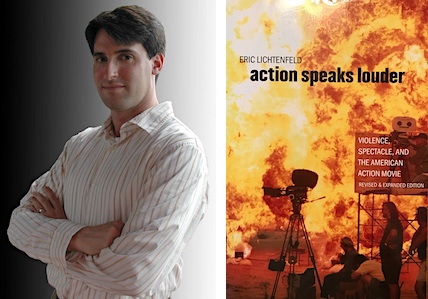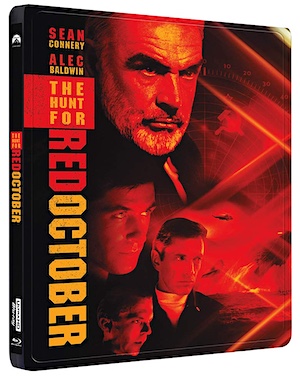THE Q&A
Eric Lichtenfeld is the author of the book Action Speaks Louder: Violence, Spectacle, and the American Action Movie (Wesleyan, 2007), an authoritative and entertaining study of the action film genre.
Eric has written about film for Slate and The Hollywood Reporter, and moderated panel discussions for the Academy of Motion Picture Arts and Sciences (including a 2010 screening of The Hunt for Red October and 2011 screening of Raiders of the Lost Ark) and the American Cinematheque. He has taught film at Loyola Marymount University, UCLA, Wesleyan University, and the Harvard School of Law. Eric has also contributed supplemental material for several DVD and Blu-ray releases, including Speed, Predator and Die Hard.
Lichtenfeld kindly spoke to The Bits about the appeal and legacy of The Hunt for Red October.

Michael Coate (The Digital Bits): In what way is The Hunt for Red October a significant motion picture? How do you think it should be remembered on its 30th anniversary?
Eric Lichtenfeld: It’s significant in how it rewards the audience’s attention and intelligence. It should be remembered as the height of what filmmakers could achieve working in a form we just don’t see much anymore: the studio-backed, well-funded dramatic thriller. Even more, though, it should be remembered as an ageless viewing experience despite its being set against a very specific geopolitical context.
The sense that the film was “the thinking man’s thriller” or that Jack Ryan was “the thinking man’s hero” became the lens everyone seemed to view the movie through. As a consequence of that, the emotionality of the movie — mostly kept on a low flame — has never been appreciated enough. So it should be remembered, or maybe reevaluated, as a film with a lot of heart.
It should also be remembered as the last Cold War movie the world would need.
And as one of the greatest collections of voices ever assembled for a live-action film.
Coate: What do you recall about the first time you saw Red October?
Lichtenfeld: Specifically, the transition from Russian to English as the angle closes in and then widens back out. More generally, feeling like this was something substantial in a way I wasn’t used to. At the time, I didn’t know enough to be as enthralled as I wish I had been. That’s okay, though; I was young.
Revisiting it over the years as a more mature movie-person and a more mature person-person, I saw so much more in it: technically, aesthetically, narratively, and even personally. Years ago, the director, John McTiernan, became a friend. For Red October’s twenty-fifth anniversary, I wrote him a letter telling him what the film had come to mean to me, as someone who’d always spent a lot of his time in his own head, not unlike its depiction of Jack Ryan (though the similarities pretty much end there). For all I know, he thought I was crazy… but from what I was told, he kept the letter!
So comparing my feelings from that first viewing to later ones? I wouldn’t say it’s a movie that’s grown on me; I’d say that it’s a movie that I’ve grown with.
Coate: Sean Connery and Alec Baldwin…good choices to play their respective roles?
Lichtenfeld: Alec Baldwin’s performance is perfect, and it was the perfect moment in his career for him to play Jack Ryan. He wasn’t so big a star that his persona cast a shadow over the character. And that was to his advantage because a key part of the movie is that this Jack Ryan is in a world that’s so much bigger than him, and populated by characters whose personas are so much bigger than his.
As for Sean Connery, he almost wasn’t in the movie. It began shooting with Klaus Maria Brandauer cast as Ramius, but he dropped out one week into production. When Connery was offered the role, he turned it down because he didn’t think the story made sense in the era of glasnost that had begun under Mikael Gorbachev in 1985. Luckily, it just turned out that when the script had been sent to Connery, the first page, explaining that the story takes place in 1984, had been missing from the fax. The moral of the story is that history can work in weird ways, but thank goodness when it works. I can’t think of another Scotsman I’d have cast to play a Russian submarine commander! Even more than James Bond, Marko Ramius will always be the Sean Connery of my imagination.
Coate: In what way was John McTiernan an ideal choice to direct, and where do you think the film ranks among his body of work?
Lichtenfeld: McTiernan was the perfect director because of his passion for naval history and also because of who he is as a filmmaker. For one thing, he’s very skilled at laying out space. In many of his movies — especially the two that he made before Red October — he makes complicated geography really clear for the audience. That’s just as true in this movie, which allows the audience to always know where it is, which sub it’s on, etc.
Even more than that, though, McTiernan has a wonderful sense of gamesmanship and of adventure that gives a dynamic charge to the very cerebral source material. And most of all, he’s a shrewd and sympathetic observer of people and how they behave. That informs even his more outlandish movies, like Die Hard with a Vengeance, and it’s a powerful asset in Red October. Again, the source material is so cerebral and so technical that it would have been easy for a director to get lost in that. But McTiernan always brings our attention back to the fact that these things are happening to people — and he does it with subtlety and consistency.
As for where it ranks among his other films, it was more than a worthy follow-up to Die Hard, which was a masterpiece of the genre and only McTiernan’s second studio feature. Which of the two is the better movie? That’s easy — whichever I’ve seen more recently!
Coate: Where do you think Red October ranks among films’ with a Cold War theme?
Lichtenfeld: That’s a very big field, but I’d have to say it’s close to the top — on the strength of the filmmaking alone, if nothing else. And don’t forget, as Cold War-themed films go, Red October had a big problem in that the Cold War kind of… ended while they were in post-production. I mean, that was a good thing for the world, just maybe not for the movie. So The Hunt for Red October should have been dated before it even opened — which means that the fact that it not only succeeded at the time, but has endured over the thirty years since, says a lot.
Coate: Do you believe Red October has been well represented on home video formats over the years?
Lichtenfeld: I can tell you that, over the years, home video releases of Red October have been well represented on my bookshelves!
I would defer to others’ expertise on this question, including yours. I remember being thrilled when a letterboxed edition was released on VHS — on a red cassette no less. Later, I was happy enough with the DVD and Blu-ray, but a 4K edition was one of my most hoped-for releases on disc. Paramount did a great thing releasing it, both in the Jack Ryan set and now as a standalone. It’s not as showy a movie as a lot of what we’d see today, but the craftsmanship of the movie is superb and very intentional, and demands to be seen in the finest presentation possible.
Coate: What is the legacy of The Hunt for Red October?
Lichtenfeld: Superficially, it launched the Jack Ryan franchise — at least all of its filmed incarnations. But it stands apart from them, too. Maybe it’s because it was first, or maybe it’s because I’m biased, but I always feel like it’s more its own entity than any of the others. It’s not a Jack Ryan property; it’s The Hunt for Red October.
I had the privilege of being asked to present the movie by the Academy of Motion Picture Arts and Sciences in celebration of its twentieth anniversary. Before I spoke, the person who introduced me told the audience in his remarks that Red October is one of those movies that he simply has to keep watching whenever he comes across it on TV. Based on the audience’s reaction, he was speaking for a lot of people — mainly guys, perhaps, but I like to think it’s people in general — and putting The Hunt for Red October in the company of films like The Godfather or The Shawshank Redemption.
That may seem like a small thing — and certainly an unscientific one — but I think it speaks to something bigger. I like to think that there’s a cultural consensus that this is simply a great movie.
I still shake my head at the thought that it didn’t get more Academy Award nominations (though I was proud to have on stage the filmmakers who had been nominated in the technical categories). Ultimately, though, awards don’t do much to shape a movie’s legacy; from a cultural standpoint, they’re snapshots. What determines a movie’s legacy is the love viewers continue to have for it over time. Whenever Red October comes up in conversation, I never see anyone shrug and go, “Oh yeah, that one was pretty good.” I see them light up. And they should light up. Because for all its complexity and all its depth, it is one of the simplest — but also rarest — things: a great story perfectly told.
Coate: Thank you, Eric, for sharing your thoughts about The Hunt for Red October on the occasion of its 30th anniversary.
--END--
IMAGES
Selected images copyright/courtesy Bobby Henderson, Los Angeles Times, Paramount Pictures, Paramount Home Entertainment.

SOURCES/REFERENCES
The primary references for this project were regional newspaper coverage and trade reports published in Billboard, Boxoffice, The Hollywood Reporter, and Variety.
All figures and data included in this article pertain to the United States and Canada except where stated otherwise.
SPECIAL THANKS
Academy of Motion Picture Arts and Sciences, David Ayers, Sheldon Hall, and Bill Kretzel.
IN MEMORIAM
- Don Bassman (Supervising Re-Recording Mixer), 1927-1993
- Richard Jordan (“Jeffrey Pelt”), 1937-1993
- Anthony Peck (“Lt. Comm. Thompson, USS Dallas”), 1947-1996
- Donald Stewart (Screenplay), 1930-1999
- Larry De Waay (Executive Producer), 1942-2003
- Basil Poledouris (Music), 1945-2006
- Peter Zinner (“Admiral Padorin”), 1919-2007
- John McTiernan Sr (“Advisor #2”), 1921-2008
- A.C. Lyles (“Advisor #1”), 1918-2013
- Tom Clancy (novel), 1943-2013
- Fred Dalton Thompson (“Admiral Painter”), 1942-2015
- Terrence Marsh (Production Designer), 1931-2018
-Michael Coate
Michael Coate can be reached via e-mail through this link. (You can also follow Michael on social media at these links: Twitter and Facebook)






